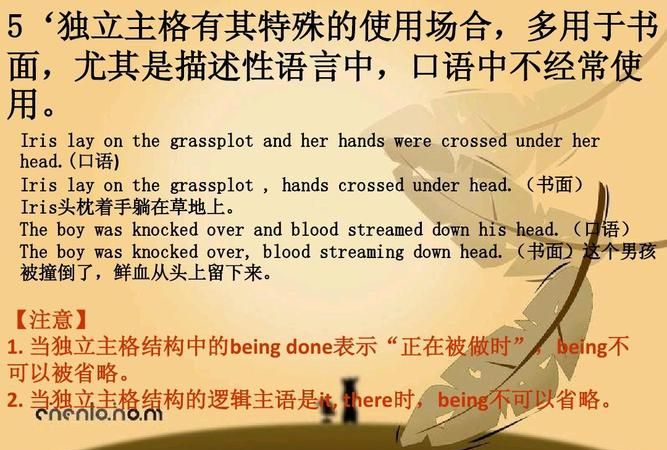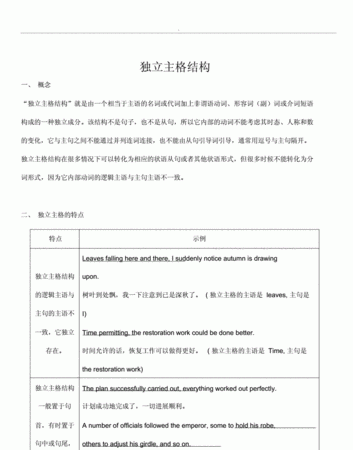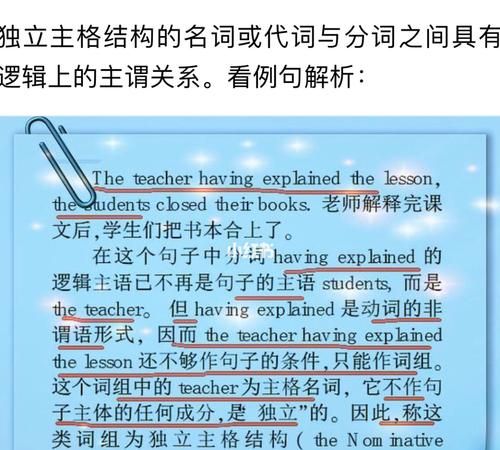本文目录
英语的独立主格结结构是什么
不是 一、独立主格结构的概念及基本构成形式
独立主格结构(the absolute structure)是由名词或代词加上分词或分词短语构成的一种独立结构,用于修饰整个句子,而不是一个词或词组。独立主格结构中的名词或代词与其后的分词或分词短语构成逻辑上的主谓关系。这种结构与主句不发生句法上的联系,独立主格结构的位置相当灵活,可置于主句前、主句末或主句中,常由逗号将其与主句分开。需特别注意的是,独立主格结构与主句之间不能使用任何连接词。例如:
1)Night enshrouding the earth,nobody could make out what the dark mass was from a distance.(黑夜笼罩大地,谁也看不清远处黑压压的一片是什么东西。)
2)He lay at full length upon his stomach,his head resting upon his left forearm.(他的脊背朝天,四肢伸展,头枕着左臂,直挺挺地趴伏着。)
3)The coward was backing,his face being deathly pale,toward another room.(那个胆小鬼向另一个房间退去,脸色煞白。)
独立主格结构多用于书面语,尤其是描述性语言中,在口语和非正式文体中,一般用从句或两个句子来代替。例如,上述例句可变为:
1)Because night enshrouded the earth, nobody could make out what the dark mass was from a distance.
2)He lay at full length upon his stomach.His head rested upon his left forearm.
3)The coward was backing toward another room.His face was deathly pale.
二、独立主格结构的特殊构成形式
独立主格结构除上述基本构成形式,即名词/代词+分词(短语)外,还有如下特殊构成形式。
1.名词+介词短语
1)The mayor of Hiroshima strode at a leisure pace toward the puzzled journalist,a bunch of flowers in his hands.(广岛市市长双手捧着一束鲜花,迈着方步走向那个迷惑不解的记者。)
2)Every afternoon a very old woman hobbled past the ramshackle house,a vast load of firewood on her back.(每天下午,一个背着一大背柴禾的老妇人都会从那间东倒西歪的房屋前蹒跚着走过。)
2.名词+形容词(短语)
1)The Trojans asleep,the Greek soldiers crept out of the hollow wooden horse.(特洛伊人睡着了,于是希腊士兵从中空的木马里悄悄爬了出来。)
2)The wretched boy,who has recently been dragged from the forest to scrub floors in the barracks,is now sweeping away the snow,his hands numb with cold.(那个可怜的小男孩最近刚刚从森林中被抓进兵营里打扫地板,现在他正在扫雪,手都冻麻了。)
3.名词+副词
1)This little excitement over,nothing was to be done but to return to a steadfast gaze at my mute companion.(一阵小小的兴奋过后,除了再去死死地盯着我的哑伴外,别无它事可干了。)
2)This intermezzo over,he found himself surrounded by several stunning,
porcelain-faced Japanese women in kimonos.(这曲子过后,他发现自己身处几位穿着和服并且有着娇好面容的日本女人的包围之中。)
此外,with常常用在独立主格结构前,构成介词短语作状语。这种用法中的with不表达什么意义,因而常可省略。请看例句:
1)With a revolver in his right hand, Johnny hurled his muscular body against the door and smashed it down with a crash.(约翰尼右手拿着左轮手枪,健壮的身体猛扑在门上,轰隆一声把门撞开了。)
2)The traffic inched along,with horns honking.(汽车缓慢地向前挪着,喇叭声不断响着。)
三、独立主格结构的用法
独立主格结构在句中一般作状语,表示时间、条件、原因、伴随状况等。
1.作时间状语
1)My shoes removed,I entered a low-ceilinged room,treading cautiously on the soft tatami matting.=After my shoes were removed, I entered a low-ceilinged room,treading cautiously on the soft tatami matting.(我脱掉鞋子后,走进一间屋顶很低的房间,小心翼翼地踩在柔软的塌塌米垫子上。)
2)The governor pondering the matter, more strikers gathered across his path.=While the governor was pondering the matter,more strikers gathered across his path.(总督思考这个问题时,更多的罢工工人聚集在他要通过的路上。)
2.作条件状语
1)Weather permitting,they will go on an outing to the beach tomorrow.=If weather permits,they will go on an outing to the beach tomorrow.(如果天气允许的话,他们将在明天组织一次海滨小游。)
2)Such being the case,you have no grounds for dismissing him.=If such is the case,you have no grounds for dismissing him.(如果情况如此的话,你没有理由解聘他。)
3.作原因状语
1)The storm drawing near,the navvy decided to call it a day.=Since the storm was drawing near,the navvy decided to call it a day.(由于暴风雨即将来临,那个挖土小工决定收工。)
2)The Cossack being intent on his stalking,his foot touched the protruding bough that was the trigger.=Because the Cossack was intent on his stalking,his foot touched the protruding bough that was the trigger.(这位哥萨克人只顾专心致志地朝前大步走着,所以一只脚踩上了伸出地面的树枝,那是一个机关的起动装置。)
4.作伴随状语
1)I took my ticket,and marched proudly up the platform,with my cheeses,the people falling back respectfully on either side.=I took my ticket,and marched proudly up the platform,with my cheeses,and the people fell back respectfully on either side.(我拿着车票还有我的奶酪,雄赳赳气昂昂地跨步走向月台。人们似乎很尊敬我,纷纷向两边退去。)
2)He would appear in the doorway,gray fedora pulled low over his face,his eyes sweeping the room for any sign of trouble.=He would appear in the doorway.A gray fedora was pulled low over his face,and his eyes swept the room for any sign of trouble.(他常常出现在门廊里,一顶灰色浅顶软呢帽遮住大半个脸,眼睛扫过整个房屋,寻找滋事的迹象。)
四、独立主格结构常见出题形式及解题策略
独立主格结构是一常考项目,在各级各类考试中多以语法结构填空形式出现。例如:
1)All flights ______ ,we decided to take a greyhound.
A.were canceled
B.had been canceled
C.having canceled
D.having been canceled
2)The production ______ steadily,the factory needs an ever-increasing supply of raw material.
A.has gone up B.is going up
C.having gone up D.being gone up
此类题型的解题策略可以概括为"结构分析法",即首先分析句子结构,判断句子缺少的成分,同时注意主句与其他部分之间有无连接词,是否用逗号隔开。若有逗号而无连接词,则可对选项部分作如下初步判断:1)选项部分可能会构成状语从句或非限制性定语从句(但二者必须由从属连词或关系代词、关系副词引导);2)选项部分可能会构成起状语作用的非谓语动词短语(但非谓语动词作状语时其逻辑主语通常为主句的主语);3)选项部分可能会构成起状语作用的独立主格结构(独立主格结构有自己的主语,并可扩展为状语从句或独立句子)。初步判断后,即可联系句子,对照选项,作出选择。
上述例题1)中的选项A和B与All flights构成了句子,但该句没有任何从属连词、关系代词或关系副词引导,与主句之间也无连接词,因而是错误的,应排除。选项C和D与All flights都可构成独立主格结构,作原因状语,但根据题意,应选D,因为"班机"是"被取消"的。
同样,例题2)中的选项A和B与名词the production构成了句子,但该句无连接词连接两个句子,因而应排除。选项C和D与the production都可构成独立主格结构,作原因状语,但根据题意,"产量在稳步增长",在逻辑上是主谓关系,应用主动语态,所以应选C。
此外,独立主格结构也时常见于其他诸如Cloze Test等题型中,并能广泛运用于写作和翻译之中。可见,掌握了独立主格结构对于学生提高综合应试能力是大有裨益的

独立主格与分词的独立结构用法完全一样吗
不完全一样。分词的独立结构可以做独立主格结构。常见的独立主格结构有如下几种:
1. 名词/主格代词+现在分词。名词/主格代词与现在分词之间主谓关系。如:
The girl staring at him (= As the girl stared at him), he didn”t know what to say. 姑娘两眼望着他,他不知道说什么好。
Time permitting (= If time permits), we will go for an outing tomorrow. 如果时间允许的话,我们明天去郊游。
2. 名词/主格代词+过去分词。名词/主格代词与过去分词之间的动宾关系。如:
The problems solved (= As the problems were solved), the quality has been improved. 随着问题的解决,质量已经提高了。
Her glasses broken (= Because her glasses were broken), she couldn”t see the words on the blackboard. 由于眼镜摔坏了,她看不见黑板上的字。
3. 名词/主格代词+不定式。名词/主格代词与不定式之间是主谓关系,且强调的是一次具体性的动作。如:
He is going to make a model plane, some old parts to help. 借助于一些旧零件,他要做一个飞机模型。
They said good-bye to each other, one to go home, the other to go to the bookstore. 他们道别后,一个回了家,一个去了书店。
4. 名词/主格代词+形容词。如:
An air accident happened to the plane, nobody alive. 那架飞机遭遇了空难,无一人生还。
So many people absent, the meeting had to be called off. 这么多人缺席,会议不得不取消。
5. 名词/主格代词+副词。如:
He put on his sweater wrong side out. 他把毛衣穿反了。
The meeting over, they all went home. 会议一结束,他们就都回家了。
6. 名词/主格代词+介词短语。如:
The boy goes to the classroom, book in hand. 那男孩手里拿着书去教室。
Mary was sitting near the fire, her back towards the door. 玛丽靠近火炉坐着,背对着门。
7. There being +名词(代词)如:
There being nothing else to do, we went home. 没有别的事可做,我们就回家了。
There being no further business, I declare the meeting closed. 没有再要讨论的事了,我宣布散会。
8. It being +名词(代词)如:
It being Christmas, the government offices were closed. 由于圣诞节的缘故,政府机关都休息。
It being a holiday, all the shops were shut. 由于今天是假日,所有商店都关门了。

西班牙语过去分词独立结构
不是的,过去分词结构一般表示被动,完成,分词独立主格表示主动,进行

英语悬垂结构和独立主格结构
一般所谓的独立结构就是指“独立主格结构”。实际上,还有其它独立结构,如分词独立结构、不定式独立结构。
例如:generally speaking, to be frankly等。

以上就是关于独立主格和独立结构一样 ,英语的独立主格结结构是什么的全部内容,以及独立主格和独立结构一样吗 的相关内容,希望能够帮到您。
